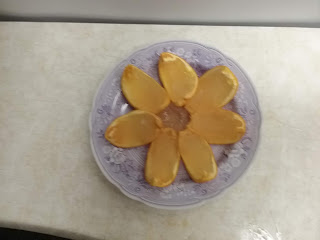The Recipe: Toffee from Cassell's Dictionary of Cookery
Toffee-- Melt three ounces of fresh butter in a small brass saucepan over a clear, bright fire. As soon as it is dissolved stir into it one pound of good brown sugar and keep stirring until it is done enough. In order to ascertain when this point is reached let a cup of cold water be placed close at hand and keep dropping a little of the toffee into it. When the toffee thus dropped hardens immediately and breaks between the teeth without sticking to them it is done and must be poured out at once or it will burn. The flavour of this toffee maybe pleasantly varied by stirring into it a tea spoonful of slightly moistened powdered ginger or the grated rind of a small lemon. Pour the toffee upon a buttered dish and put it in a cool place to set. Time to boil fifteen to twenty five minutes.
[Interestingly, Cassell's Household Guide (1869) uses treacle for half the sweetener. I also came across similar recipes throughout the century, like this from 1882 (which also has an almond variation) and it, in turn, is almost identical to one from 1832 (which admits the option of adding lemon juice to the finished product). I also found similar recipes from 1855 and from 1857 (lemon peel and juice added), and from 1869 (which allows for lemon peel or powdered ginger).]
The Date/Year and Region: London, 1883.
How Did You Make It: Melted 3 oz of unsalted butter on the stove, stirred in 1 lb of brown sugar, and kept stirring until the mixture lost its graininess (and a drop of the liquid solidified in cold water). I then poured it into buttered tins, adding 1/2 tsp of ginger to one of the pans, and scored the toffee. After it cooled, I broke toffee with a toffee hammer.
Time to Complete: About 18 minutes to melt the butter and sugar together over medium-low to medium heat; the toffee set promptly, and was fully cool within the hour.
Total Cost: About $1.50.
How Successful Was It?: Perfectly satisfactory. It tasted like toffee, though I occasionally caught a whiff of burned sugar, so I think I'll make future batches over medium-low heat only.
The ginger batch was alright: both toffee and ginger flavors came through, and it was perfectly palatable, I'm just not sure the toffee needs the ginger. I do think I'll try the lemon variant at some point, but the toffee stands well on its own. Using the toffee hammer was a ton of fun, so I'll definitely be making this again. I think future batches need deeper score lines, though.
How Accurate Is It?: I used an electric stove instead of a clear fire, but didn't knowingly make other changes.
 |
| Cooling toffee and hammer. |
 |
| Finished toffee is less rectangular than planned, still tasted fine. |






